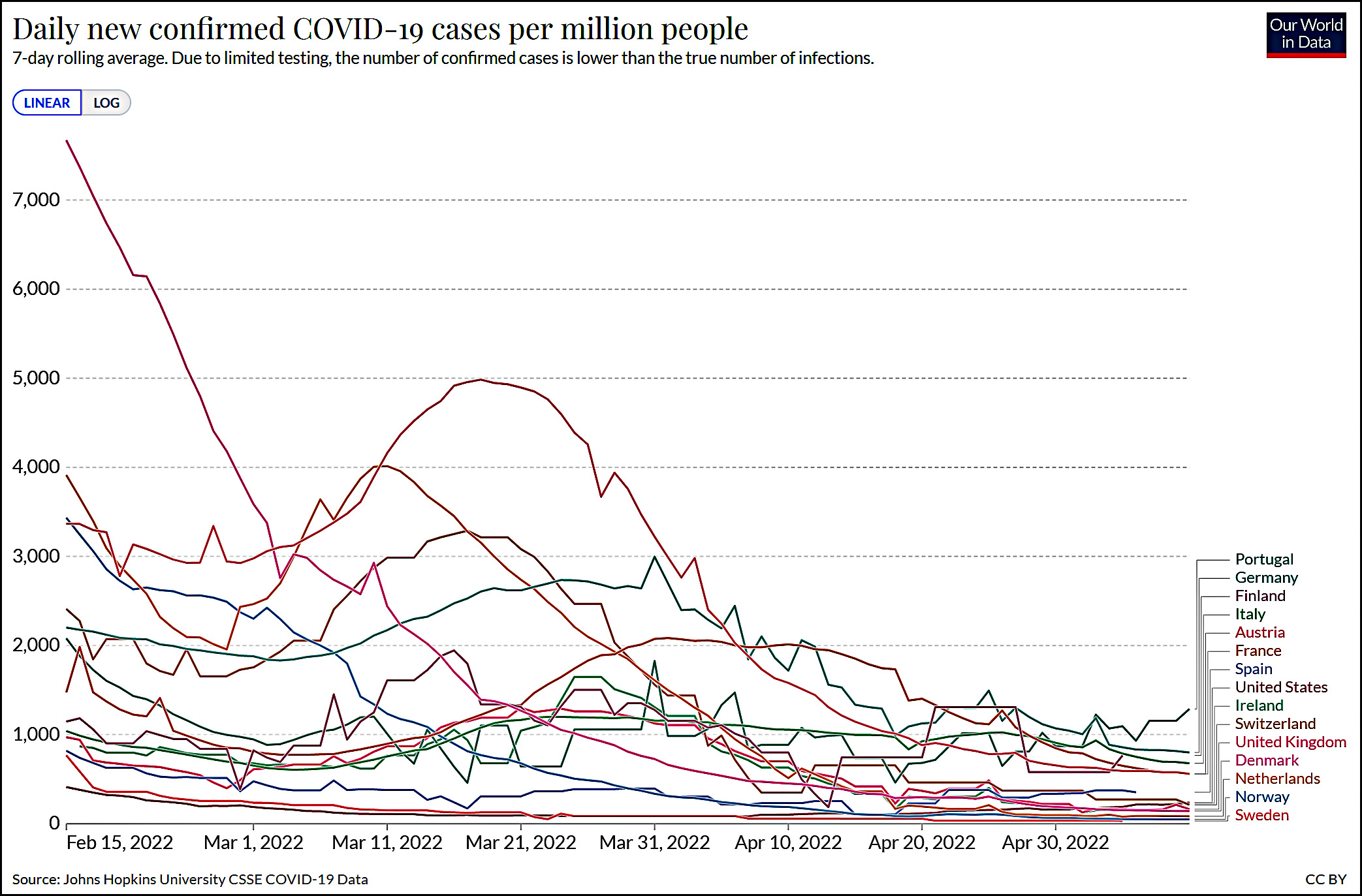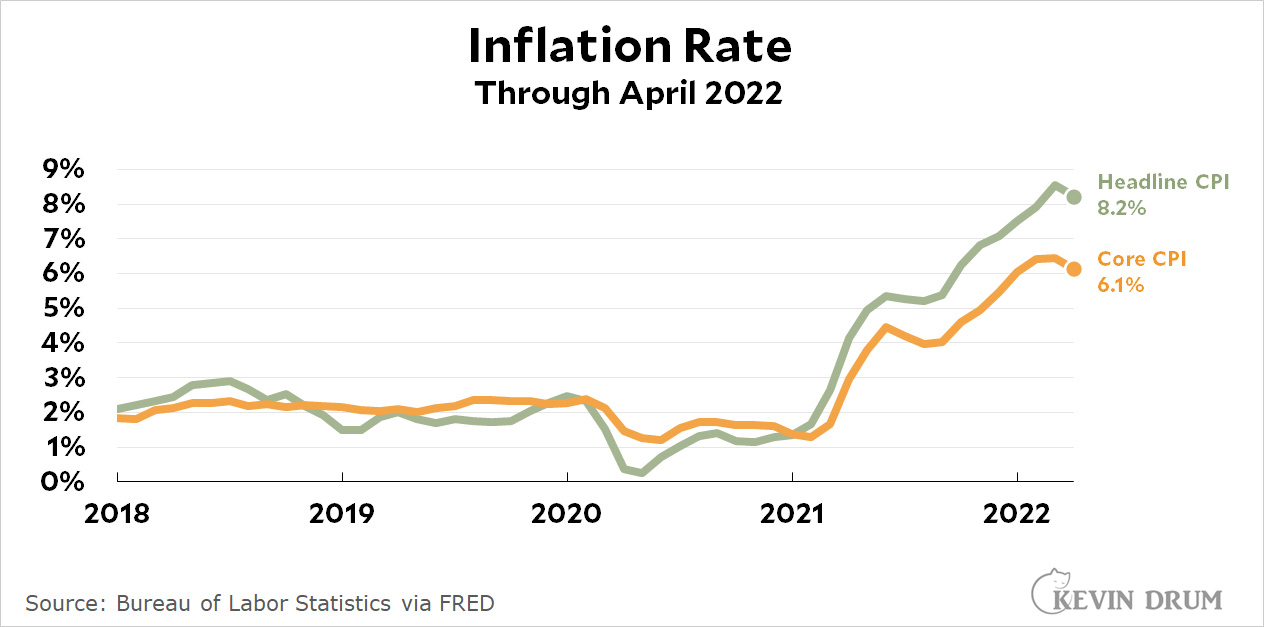I don't know what this guy was doing while I was waiting for a train at the Vermont/Sunset station on the LA Metro red line. I'm pretty sure I don't want to know.

Cats, charts, and politics

Hmmm. Finland has officially decided to apply for membership in NATO. Russia is pissed.
A lot of people under 40 or so might not understand why this is a big deal. Finland is just your standard Western democracy, after all, and has been part of the EU for decades. The only surprising thing is that they aren't part of NATO already. So what's up?
To keep things short, Finland and Russia have some history. The Soviet Union tried to invade Finland in the Winter War of 1939-40 but lost thanks to stiff Finnish resistance. Later, during the Cold War, the Soviet Union demanded—and got—promises of strict neutrality from Finland. They also demanded—and got—enormous influence over Finnish foreign policy. The whole thing was dubbed Finlandization, and in practice it meant the Soviets considered Finland something between a hostage and a client state.
So joining NATO would be a huge ego blow for Russia. In practice, neither Finland nor Russia really have any beef today, but Finland officially joining a Western military alliance would be something like, say, the Philippines joining a Chinese military alliance. Not a big deal in concrete terms, but certainly a seismic shift in alliances.
Last night someone suggested that tracking COVID-19 cases was sort of pointless these days because so many people do home testing that never shows up in national statistics. That's true, and several readers mentioned that sewage testing is the latest and greatest method for tracking COVID according to those in the know.
That got me curious, so I headed over to the CDC site and played around on their wastewater surveillance page. I wasn't able to make a lot of sense out of it, so instead I zoomed into California and then to Orange County to see how things were going in my neck of the woods:
 Is sewershed 299 the only site that shows evidence of COVID? Or is it the only testing site in Orange County? I'm not sure, but it looks like levels are very low with just a bit of an uptick starting in late April.
Is sewershed 299 the only site that shows evidence of COVID? Or is it the only testing site in Orange County? I'm not sure, but it looks like levels are very low with just a bit of an uptick starting in late April.
So then I went to the California state water board site and checked in with them:
 It looks about the same: COVID levels in wastewater are very low in Orange County, but took a tick upward toward the end of April.
It looks about the same: COVID levels in wastewater are very low in Orange County, but took a tick upward toward the end of April.
So that's that. I may try to make more sense of the data later on, but this is it for now. Click the links if you want to check out your own local area.
It's the "Breaking News" banner that I find sort of funny here.
It occurred to me that I haven't looked at COVID-19 lately, so I figured I should do that. Here's an old-school look at the daily rate of confirmed cases in various countries:
 Cases are way down all over the world. The US case rate has increased slightly since April, but it's still below 250/day compared to a high of 2,400/day during the Omicron outbreak.
Cases are way down all over the world. The US case rate has increased slightly since April, but it's still below 250/day compared to a high of 2,400/day during the Omicron outbreak.
For now, things are looking pretty calm. That's great, but I wish it weren't making everyone so complacent. There's still a likelihood of further surges, and we should be spending the money to prepare for them. It's just dumb to pretend that COVID has gone away never to return.
This is the Calvary Chapel of the Canyons located on Silverado Canyon Road. On its own it isn't an especially great looking church, and I long ago gave up on trying to take an ordinary shot of it.
But then, several months ago, I happened to be out in the area when I saw the church from a distance on an evening when the moon was lighting it up. This inspired me to try to take a picture of the church from about half a mile away, but I was never able to take a single image that satisfied me. So I decided to create a composite instead.
This is a very carefully constructed image. The base layer is a photo I took when the moon was full. The next layer is a picture I took with my phone on Monday night. It has lovely clouds and a sky full of stars. In the area around the moon, I made the layer semi-transparent so the moon was visible, and then brightened it up.
The final layer is the foreground hills. I took dozens of versions of this on different days, and then applied different effects to brighten up the area around the church. My Photoshop skills are not up to this, but I ended up liking this version better than any of the others.
Even though I'm not entirely satisfied with this, I'm posting it in order to get it off my plate. I do this sometimes when I've spent too much time trying to capture a perfect shot with no success, and the only way to stop myself is to put it on the blog so there's no point in trying any further. The result is worse photography for you but better mental health for me.

Last month, 30-year fixed mortgage rates hit 5%, up from 3% at the end of 2021. But that didn't even slow them down. Rates busted right past that 5% level and are now at 5.27%:
 How much is this really? Here's a chart that shows how much the rise in interest rates has affected the monthly payments on a $500,000 mortgage:
How much is this really? Here's a chart that shows how much the rise in interest rates has affected the monthly payments on a $500,000 mortgage:
 At the beginning of the year, the monthly payment on a $500,000 loan was $2,138. By the middle of April, when interest rates hit 5%, that had gone up $546. In the past few weeks, it's gone up by another $83.
At the beginning of the year, the monthly payment on a $500,000 loan was $2,138. By the middle of April, when interest rates hit 5%, that had gone up $546. In the past few weeks, it's gone up by another $83.
In all, monthly payments on a $500,000 mortgage have gone up from $2,138 at the beginning of the year to $2,767 this week. That's an increase of $629 for this particular size of mortgage. If you prefer percentages because they stay the same no matter the size of the mortgage, it's an increase of 30%. But no matter how you like to look at things, this is a very, very big surge. Can the current housing boom withstand this?
The CDC released drug overdose death figures for the full year 2021 today. Here they are:
 Fentanyl accounted for 64% of total opioid deaths in 2021. Fentanyl overdose deaths have increased from under 10,000 in 2015 to nearly 70,000 in 2021.
Fentanyl accounted for 64% of total opioid deaths in 2021. Fentanyl overdose deaths have increased from under 10,000 in 2015 to nearly 70,000 in 2021.
A few days ago I asked what was really behind the Russian army's epic incompetence in Ukraine. It's a standard war, not a counterinsurgency, so you'd think Russia could do OK. Why isn't it?
A longtime reader writes in with this explanation:
I do have some information as to why the Russian Army is so terrible. The answer is that it utterly lacks a Non-Commissioned Officer corps. This means that there is no enlisted group with institutional memory, nor training, nor technical competence. ALL of that is thrust onto the shoulders of junior officers, and speaking from institutional memory and from experience, junior officers are not up to the many tasks assigned to them. The Russian Army is infamous for its hazing of enlisted personnel, rape is common, and nobody, but NOBODY offers creative solutions in that kind of environment.
I am a retired NCO, son of a career NCO, and you may think that this is prejudice. When I was on active duty, I regularly questioned the judgement of junior officers and at least annually went over their head to a superior officer (with permission). I never got into trouble for that, and never expected to. It takes just one man to sink a ship during combat and it takes just one man to ask a difficult question in difficult times to save it. EVERYONE makes mistakes. When second lieutenants get together to plan an operation, the result is predictable. That’s why those are called a “clusterfuck” (oak leaf clusters).
The Russian Army consists of well-connected senior officers, junior officers who are the sons of the senior officers, and cannon fodder.
OK then. I don't know anything about the (lack of a) Russian NCO corps, but everything I've read about the way troops are drafted and handled confirms that they are indeed treated as cannon fodder. That's a tough assignment for anyone.
Today is inflation day, and the BLS reports that the US inflation rate has finally begun to decline. The headline inflation rate fell from 8.5% in March to 8.2% in April. The core inflation rate, which excludes food and energy, fell from 6.4% to 6.1%.
 This means that our collective optimism about a drop in the inflation rate was justified. Good forecasting, folks! But if want to really see optimistic, check out inflation measured since last month, not last year:
This means that our collective optimism about a drop in the inflation rate was justified. Good forecasting, folks! But if want to really see optimistic, check out inflation measured since last month, not last year:
 Headline inflation rose 0.3% since March, which is an annualized rate of only 4.1% compared to 15.9% last month. Oddly, core inflation did just the opposite: it rose to annualized rate of 7.0% compared to 4.0% last month. This is largely because there was a large drop in energy prices, which shows up in CPI but not in core CPI.
Headline inflation rose 0.3% since March, which is an annualized rate of only 4.1% compared to 15.9% last month. Oddly, core inflation did just the opposite: it rose to annualized rate of 7.0% compared to 4.0% last month. This is largely because there was a large drop in energy prices, which shows up in CPI but not in core CPI.
Anyway, the news is largely good on the inflation front, but not so great on the wages front. Weekly blue-collar wages were up 5.5% since last year, which translates to -3.1% after you adjust for inflation. On a monthly basis, wages were up 0.2% from March to April, which translates to a real yearly change of +2.4%. That's not bad, but only if it keeps up for a full year.
Generally speaking, we saw a welcome easing in inflation, but it was about what was expected. Nobody is going to go crazy over this.
On the other hand, the massive drop in the monthly rate of inflation from March to April was, as far as I know, completely unexpected. However, it will probably be treated as a meaningless outlier due to a one-time drop in energy prices that's not likely to be repeated.